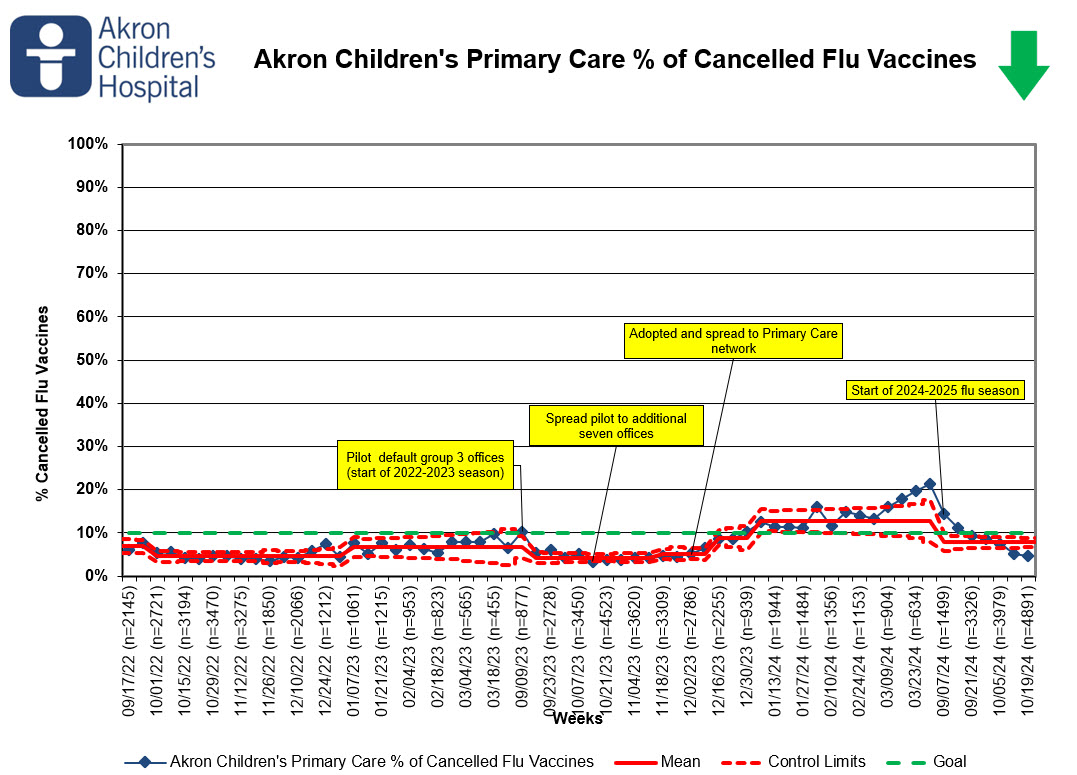Quality Improvement/Patient Safety 4
Session: Quality Improvement/Patient Safety 4
044 - Enhancing Flu Vaccine Uptake Through an Opt-Out process in a Primary Care Electronic Health Record: A Quality Improvement Initiative
Friday, April 25, 2025
5:30pm - 7:45pm HST
Publication Number: 44.4709
Hanna Lemerman, Akron Children's Hospital, Copley, OH, United States; Eric Robinette, Akron Children's Hospital, Akron, OH, United States; Laurie Engler, Akron Childrens Hospital, Akron, OH, United States; Pamela Nelly, Akron Children's Hospital, Cleveland, OH, United States

Hanna Lemerman, MD MPH (she/her/hers)
Medical Director of Primary Care Quality Improvement
Akron Children's Hospital
Copley, Ohio, United States
Presenting Author(s)
Background: Pediatric influenza vaccination rates consistently lag other recommended immunizations, primarily due to parental vaccine hesitancy surrounding the flu vaccine. This hesitancy directly influences how primary care providers approach the administration of the vaccine. Research indicates that a strong provider recommendation can effectively reassure parents and boost vaccination uptake. Historically, Akron Children’s Primary Care, a large multi-site network of pediatric outpatient clinics in Ohio, implemented an opt-out approach for childhood vaccinations but adopted an opt-in approach specifically for the flu vaccine. To improve flu vaccination administration, we modified the electronic health record (EHR) system from a manual ordering process for flu vaccine to an automatic process in line with other childhood vaccinations.
Objective: Our aim was to increase flu vaccination administration during the 2023 - 2024 season compared to the 2022 - 2023 season. As a balancing measure, we examined rates of cancelled flu vaccinations with a goal not exceeding 10% of flu vaccines ordered.
Design/Methods: We utilized the Model for Improvement with staged spread, starting with two primary care clusters and culminating in network-wide implementation. We measured weekly flu vaccination rates alongside balancing measures tracking the number of canceled vaccines and reported errors. We shared the data weekly with the pilot groups and across the network. We made improvements in the EHR build based on feedback from providers.
Results: In season 2023-2024, nearly 60,000 vaccines were administered, which was an additional 11,057 flu vaccines compared to the prior year. Our intervention led to a peak flu vaccination rate of 39%, surpassing the previous year's rate of 36%. Throughout the majority of the season, there was no significant impact on cancelled vaccine orders and no serious patient safety events reported. This season’s early data indicates continued improvement.
Conclusion(s): Implementing the opt-out process through the EHR proved to be a safe and effective strategy for enhancing flu vaccination rates. This approach facilitates stronger provider recommendations and addresses vaccine hesitancy, ultimately contributing to improved public health outcomes in pediatric populations.
Akron Children's Primary Care Flu Vaccine Run Chart
.jpg) Figure 1
Figure 1Akron Children's Primary Care Percentage of Cancelled Flu Orders P Chart
 Figure 1
Figure 1
